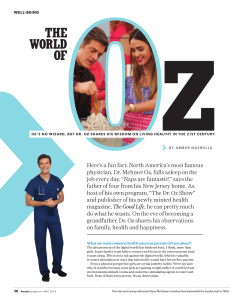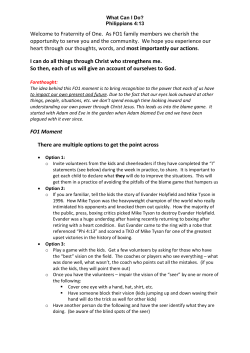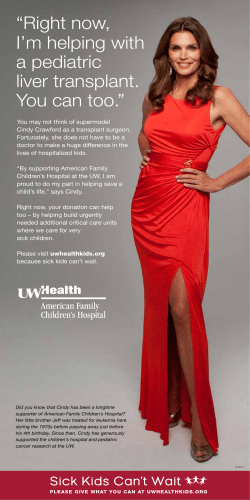
F By Andrew Holtz, MPH
PAGE 45 / DECEMBER 10, 2007 SCRIPTDOCTOR: MEDICINE IN THE MEDIA Shaq’s Big Challenge: Tougher than Winning the NBA Championship By Andrew Holtz, MPH at is in—at least on Reality TV. Look at Biggest Loser, Fat March, and Celebrity Fit Club, for example. These shows follow familiar reality show formats: In addition to mundane weight-loss advice and assistance, the shows generally feature strange competitions and back-biting between contestants. But in contrast to those contest-style shows, earlier this year there was at least one reality show that tackled obesity without humiliating participants. Shaq’s Big Challenge had a six-week run on ABC this summer. Miami Heat basketball star Shaquille O’Neal (Shaq to his fans) took on a task that one of his old college coaches told him would be tougher than winning an NBA Championship: Getting six heavy— very heavy—middle-school kids to lose weight. It was adapted from a British series called Ian Wright’s Unfit Kids. When I first tuned in, I was expecting to see the common focus on the individual “failings” of each kid. But the show wasn’t like that at all. Executive Producer Rick Ringbakk says they wanted to avoid the type of reality show formats that are designed to heighten conflict and drama. “If we were to have gone at this from a reality television standpoint, we probably would have opened up and tried to cast from the entire country, looking for the six most explosive personalities of kids that you could find,” he said. “We didn’t look at it that way at all. We said, ‘OK, what are the major contributing factors to a child becoming obese in today’s society?’ It’s sedentary lifestyle; so we knew we wanted somebody who represented the population of kids that spend 60 to 70 hours a week in front of a screen, be it video games, watching television, etc. We knew that we wanted a situation with a single parent who just felt like they didn’t have time to be cooking, so the 99-cent menu had become the staple of the diet. “Those sorts of casting choices are much more geared to documentaries, because you are trying to tell the story of an issue before you are trying to tell the story of a personality conflict.” The Broward County, Florida school system took a chance on the show, allowing crews into two middle schools to select students, but also to examine the schools themselves, including PE, health classes, and school lunches. F Wanted to Avoid Pinning Blame on Children Both Ringbakk and medical advisor Carlon Colker, MD, Shaq’s personal physician and trainer, say they wanted to avoid pinning blame on children by focusing on the circumstances that foster obesity. “We don’t need to pit them against each other and make them compete against each other and have to prove themselves and humiliate them through that whole ritual of building up and tearing down that we are so good at doing as Americans,” Dr. Colker said. The show repeatedly pointed out that only 6% of schools in the US have mandatory physical education classes, along with other factors that make it tougher than ever for American children to be healthy. “We’re calling everybody out on this,” Dr. Colker said. “It’s a problem. We’ve got to do something about it. It’s systemic. It’s epidemic. It’s a disaster. And we’ve got to intervene. It’s part of our school system, with the school lunches, as we showed. It’s the fast ABC/Angelo Cavalli food businesses and those kinds of organizations coming in and sprinkling their fish food around the schools and trying to poison our children. That may sound harsh to say, but that’s just what I believe. “When there’s cookies and soda and all sorts of stuff that’s cheap and accessible to these kids, they’re going to eat it. It doesn’t have to be this way, but we have to hold everybody to task on this. There’s no reason we shouldn’t have physical education in every school system for every child.” Andrew Holtz, Third of a three-part series Attack on Fast Food Is Noteworthy The attack on fast food is noteworthy, since food companies are major advertisers. Indeed, a recent study by the Kaiser Family Foundation found that kids see 15 to 20 food ads on TV each day and about a third of those ads are pushing candy or snacks. The final episode of the Shaq series featured ads for movies, cars, credit cards, and cell phones, but no food ads, if you don’t count a spot for sugarless gum. What’s more, the athletic director at one of the featured schools said that MPH, is a former CNN Medical Correspondent and the author of “The Medical Science of House, M.D.” Send questions to him about how the media treat medical topics or suggestions for future columns to [email protected] if mandatory PE classes are not reinstated, then the war on obesity is lost and we might as well just start handing money over to drug companies to treat obesity-related diseases. Of course, pharmaceutical companies are another mainstay of TV advertising. Actually, it’s almost a surprise that the network went ahead with a series that was openly hostile toward major advertisers. Surprised by What Saw in Schools At a media event held just before the series debuted, Shaq said that what he saw in the schools surprised him: “I was most surprised by what they were serving for lunch every day,” he said. “The schools that we visited, every day—it was sort of like the schools are promoting fast food. I was also surprised how big of an epidemic childhood obesity is and the things that it can cause and the number of deaths around the country related to obesity-related issues. So I actually learned a lot also being involved with the show.” The choice of a basketball player to host a show about childhood obesity may seem odd, but Shaq has several advantages over an expert on obesity. First, he’s a celebrity, and that always helps attract viewers. Second, he’s struggled with his weight, so he has a connection with the challenges facing the kids. (Indeed, at 325 lbs. his body mass index is in the obese range, even though he’s more than seven feet tall. (Of course, Shaq is an outlier; the normal cateShaquille O’Neal surrounded by the kids from the show (left to right) Kevin Evans, gories don’t fit a world-class Ariel Pittsinger, Chris Britto, Kit Maldanado, James Pistocchi, and Walter Holleger. athlete.) The kids lost a total of 25 to 77 pounds each over the course of nine months. (continued on page 46) PAGE 46 / DECEMBER 10, 2007 POETRY BY CANCER CAREGIVERS he world of poetry is a means of expression and source of comfort for many who care for cancer patients. We welcome submissions from oncologists, oncology nurses, oncology pharmacists, and other cancer caregivers. E-mail only, please, to: [email protected], and include your affiliation/title, address, and phone number, along with a photo, if available. T Frank L. Meyskens, Jr., MD, is the Daniel G. Aldrich, Jr. Endowed Chair and Professor of Medicine and Biological Chemistry at the University of California, Irvine; Director of the Chao Family Comprehensive Cancer Center; and Associate Vice Chancellor in the College of Health Sciences. Dr. Meyskens is a member of OT’s Editorial Board and it was his suggestion to include poetry as a regular feature. “Aching for Tomorrow,” his new book of poems, was published at the end of October and is available from Fithian Press, 800662-8351, www.danielpublishing.com/bro/meyskens.html All author's royalties are being contributed to the Meyskens Patient Care Fund (for nonmedical expenses) of the Chao Family Comprehensive Cancer Center. Regarding this poem, “Not Enough,” he says, “Some clinics are harder than others.” ScriptDoctor continued from page 45 Third, his lack of expertise allows him to represent viewers—instead of lecturing to them. “Shaq was not a childhood obesity expert by any stretch,” Ringbakk says. “We felt it would be incredibly compelling for the audience to learn about it as Shaq learned about it, as opposed to starting with somebody who is already incredibly versed in the subject and is essentially lecturing to the audience. We just felt that a much more palatable way for the average viewer to ingest the information would be by discovering the issues as Shaq discovered them.” Saw Attitude Shift And that’s how it worked out. Shaq starts out thinking the kids are just a little bit chubby. You get to watch his attitude shift as he hears from a physician about the health consequences of morbid obesity. Then he tries simply giving the kids encouragement, diet and exercise information, and access to a gym. After that low-key approach fails miserably, Shaq and viewers are ready to learn more about the causes and cures of obesity as they search for effective countermeasures. He sets his sights on changing school lunches and curricula, and finding ways to help parents provide better diets and environments at home. “It was very emotional. You know, when I first took on the thing, especially after watching other shows, especially with me being an athlete. I said, OK, I could take six kids and get them to work out every day, but it’s beyond that. It’s their attitudes, what they’re getting fed in schools, what’s going on in the schools. It was very emotional,” Shaq said. “The most emotional part is when we took the kids to the doctor, Dr. Muinos, who was a childhood obesity specialist down in Miami and he explained basically what can happen to them. And he showed them pictures of other obese children who became obese adults and what could happen to them.” The series was entertaining. Our kids enjoyed watching it. And I think they and other viewers understood the public health messages without ever really realizing they were getting a bit of an education in the social determinants of health. In the end, the kids in the show did lose weight and improved their fitness. But even more impressive was the way the show not only talked about larger societal forces, but tackled them. Viewers got to see school officials resist NOT ENOUGH By Frank L. Meyskens, Jr., MD I have been your doctor for eighteen years often wondering from whence the fortitude that allowed you to live, with a grace and ready smile, with a disease that was there for all to see. Ulcerating, fungating, penetrating year after year but always responding, at least for a while to our latest potion or manipulation, us one step ahead of the transformation, and your laughter and love of life always there, But not this time, not today. What’s it now, regimen eight or nine, the ugliness now crawling where it was not supposed to go… rotting your face as if you were a leper. Dressed in your best finery, today a brave smile, a single tear and then tears, more tears, and then a flood. A hand-written note with entreaties asking me not to abandon you, like an arrow through my heart. “There has to be something, Dr. Meyskens” Yes a new medicine, and the cancer is in retreat “But I am sleepy all the time and I can’t enjoy life” Not enough, not enough, even at seventy-eight. and then help shape new lunch menus and health curricula. They got to see a celebrity chef flounder in his first attempts to cook a healthy meal in a school cafeteria, one that the students would actually eat. And they saw the shock on the chef’s face when he was told that in order to get a new menu accepted he’d have to find a way to produce it within an astonishingly tight budget: just one dollar per meal. Eventually, he met that challenge. Pleading with Florida Governor for State Support But the show looked even farther, beyond the kids, their families, and their schools. In the final episode, Shaq and the kids met with Florida Governor Charlie Crist to plead for state support. Things came together almost too neatly at the end, with the Governor endorsing Shaq’s proposals in front of a cheering crowd on the capitol steps. There must have been plenty of offcamera negotiations and preparations for the event. Indeed, according to news reports Gov. Crist had been pushing for the return of PE to Florida schools since he took office last January. He wasn’t the sudden convert the show implied. Also, the show couldn’t provide any follow-up to see how the promises were implemented. Key Lessons There are a few key lessons from this example. It is possible to produce a reality TV show that skips cheap and easy tricks designed to create artificial conflicts and drama. And a reality TV show can step beyond the usual focus on individual anecdotes in order to slip in strong information about social, political, and economic forces that influence health. But the example of Shaq’s Big Challenge also illustrates why most reality TV shows, including those that deal with obesity and other health issues, aren’t as enlightening. For one thing, the show probably cost more per hour than most reality shows. “Nine months to make six hours of television is not the best business model within the television world, when you’ve got game shows shooting two or three episodes a day and drawing huge numbers,” Ringbakk said. “But I think from the network’s standpoint, from our standpoint, from Shaq’s standpoint, for everybody who was involved, it really was a labor of love. And everybody got behind the idea that this was just an important story to tell.” But network television isn’t based on labors of love. It’s all about delivering the biggest audience to advertisers. This show got only mediocre ratings. (continued on page 48) PAGE 48 / DECEMBER 10, 2007 Nancy Brinker’s ‘Bridge between Society and Science’ Spans to State Department By Eric T. Rosenthal ASHINGTON, DC—Thirty years ago, Nancy Brinker made a now-famous promise to her sister Susan—who was dying of breast cancer—that she would do everything in her power to end W breast cancer forever. That promise led to the founding of what is now called Susan G. Komen for the Cure, the largest grassroots network of breast cancer survivors and activists in the world. This past June—just prior to her appearance as a speaker during the American Society of Clinical Oncology’s Annual Meeting Plenary Session—Ms. Brinker’s dying father asked her “to make a promise to me that you will return to serving our country and this President.” That was a promise related to her accepting President Bush’s nomination as Chief of Protocol for the US State Department, a term that officially began September 14, and which she dedicated to her father. Several weeks later, on a summerlike mid-morning autumn day in the State Department’s august Benjamin Franklin Room, First Lady Laura Bush, various Cabinet Secretaries, Ambassadors, and other government officials joined friends, family members, and associates from the worlds of philanthropy, the media, advocacy, and oncology to witness Secretary of State Condoleezza Rice swear in Nancy Goodman Brinker as Chief of Protocol. It was a return to service in the State Department—from 2001 to 2003 she was US Ambassador to Hungary. This current position includes advising, assisting, and supporting the President, Vice President, and Secretary of State on official matters of diplomatic procedure, as well as accompanying the President on official visits abroad, and serving as his personal representative and liaison to the 184 foreign ambassadors in Washington, DC. ScriptDoctor continued from page 46 “We never had any expectation that this was going to be a massive hit, because it is a niche, and the reality of the television landscape is that not everybody likes to watch a television show that requires thought or discussion,” he said. “But what we hoped at least was that the viewers who came to the show, who had an interest on some level, would stay with the show; and they did. The show has grown every week.” The final episode was seen in about four million homes. It was third in its time slot, with about half the viewership of, for example, The Singing Bee, a game show in which contestants have to complete lyrics from popular songs. Companion Web Site References: 1. Escudier B, Szczylik C, Eisen T, et al. Randomized phase III trial of the multi-kinase inhibitor sorafenib (BAY 43-9006) in patients with advanced RCC. Paper presented at: ECCO 13— the European Cancer Conference; November 3, 2005; Paris, France. 2. Data on file, Bayer Pharmaceuticals Corporation, 2006. © 2007 Bayer Pharmaceuticals Corporation, West Haven, CT SS1002907T 3/07 Printed in USA A companion Web site, www.shaqs familychallenge.com, got almost a million hits in a month. But the relatively low-key promotion for the show, its short six-week run, the fact that it ran in the middle of the summer doldrums, and the lack of any firm plans for another series are all indications that the network executives don’t see this sort of program taking over primetime. In sum then, Shaq’s Big Challenge demonstrated both that reality TV can combine entertainment with valuable health messages—and why that combination is more the exception than the O T rule.
© Copyright 2025









